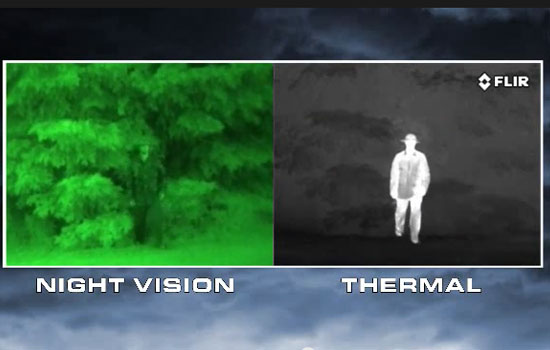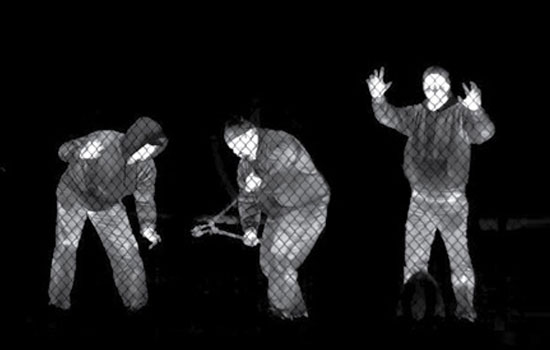Law Enforcement Thermal Camera Applications
Thermal cameras used in law enforcement allow police officers and security professionals to track, locate and capture criminals more efficiently in adverse weather conditions, dense foliage, woodland or various other factors that can contribute towards a criminal remaining hidden, leaving on-foot patrolmen unable to detect criminals who might be hiding.
Understanding How Thermal Cameras Work
Before you can understand the benefits of a thermal camera, you need to understand exactly how these devices work. Although they may have camera in their name - and function in a similar fashion to standard digital cameras - a thermal camera is a very different thing altogether. Where a normal camera sees the world as visible light (much like we do with our eyes) a thermal camera utilises a special thermal lens to detect IR (infrared) light which is completely invisible to the human eye.
Infrared radiation is given off by absolutely everything around us. Our own bodies do it, as does something like a fridge. A thermal imaging camera is able to detect this radiation - known as 'emissivity' - and convert the radiation via complex algorithms into an image. The image in question will show the world as a collection of different colours, with whiter objects being extremely hot, and darker objects being colder. The presentation of the image depends entirely on the camera being used; many different devices offer different palette options so users can get the best possible imagery at all times.
The use of this technology is vast, and thermal imaging systems are rapidly becoming used in every industry from electrical work to detecting wildlife. In the case of using the devices as an aid for law enforcement professionals, these tools have proven time and time again to be an extremely effective device to add to any lawman's arsenal of equipment.
Criminals Can Hide, But Their Heat Can't
Imagine you're a policeman chasing down a criminal. The chase starts in vehicles with the officers in close pursuit of the target. Suddenly the criminal pulls to a screeching halt, leaps out of the vehicle and heads into the nearby woods, filled with dense foliage and extremely dark at this time of night. The policemen soon stop as well and emerge from their car, only to find they can't see anything and finding the criminal is almost impossible (and potentially dangerous) in the environment they've suddenly found themselves in.
It's a scene that's extremely common. It may not play out exactly like this, but a criminal will nearly always try to hide from the police if they're on the run and many times - simply due to human's inabilities - the criminal is able to evade capture and slip away unnoticed.
Now imagine the same scenario, but imagine that one of the police officers steps out of the car with a thermal imaging system in hand. While his fellow officer calls for backup the patrolman scans the immediate environment with his thermal camera, sweeping across the entrance to the woodland.
By looking through the thermal camera the darkness of the wood isn't an issue - the camera doesn't rely on visible light to operate and the officer can clearly see heat distribution amongst the trees. He can also see the criminal nearby, who is lying down in a bed of leaves trying to conceal himself. The criminal has been let down by the heat of his body and the officer quickly moves to arrest the criminal who thinks he's perfectly hidden in his pile of leaves. The same principle could be used if the criminal was standing behind foliage; the heat of the criminal's body will always show up clearly on the thermal camera and he can be captured without extensive dangerous searching in a difficult environment.
This is just one example of how thermal cameras can be deployed by policemen, but there are countless other uses as well. A thermal camera could, for example, detect a vehicle that's recently been running, implying that a person the police might be tracking is nearby.
Thermal From The Air
Thermal technology doesn't have to be deployed on foot either. Commonly seen on TV programmes about police, thermal technology based in aircraft such as planes or helicopters has been adopted to allow a comprehensive view of the environment to be displayed in full thermal, aiding officers on the ground by tracking criminals on the run.
Tracking from the air offers a number of advantages over doing so on foot, the most important of which is the expanded field of view. The helicopter high above isn't limited by buildings, foliage or other aspects of the land getting in the way - instead it can see everywhere around and can accurately track a criminal's movements through an environment. The helicopter can also easily keep pace with fast-moving cars, helping officers to keep co-ordinated on the ground as the helicopter armed with thermal can relay information about where the criminal is travelling, thus ensuring that officers don't lose criminals who are fleeing the law.
Significantly Better Than Nightvision
Nightvision cameras can be an effective method of seeing through darkness, but they're let down significantly by the fact that they still rely on some form of visible light to make an image. This means that, despite some illumination of the environment taking place on the camera, that much can remain unseen.

In direct comparison, thermal imaging cameras are significantly better at detecting things that might have remained hidden in darkness. You only have to look at the image above to see the stark difference in appearance; where the man on the left is almost cloaked on the green tinged image, he is completely visible due to his heat signature being registered by the thermal imaging system used to take the image on the right.
This is because thermal cameras do not rely at all on visible light to construct an image. Instead these devices use IR light to detect the heat emissivity of an object and the hottest object - in this case the man in the image - will be much brighter in appearance than the foliage around him.
The Security Professional's New Best Friend
Forget the image of a security patrolman flanked by his trusty Alsatian friend - modern technology such as thermal imaging cameras are a much more effective tool for tracking criminals who are trying to break into an area.

Security-based thermal systems generally tend to come in two forms. The first of these is CCTV-mounted thermal imaging, while the second is deployed on foot by security professionals to scan an environment. Both have their merits and both are extremely effective tools for detecting those who are in areas where they shouldn't be.
Handheld units are an extremely effective tool for seeing through darkness. Just like in police applications, darkness can be the difference between a criminal being spotted and remaining hidden; under the cover of night, criminals are more likely to be active and are thus less likely to be noticed. By using a thermal imaging system security professionals are able to completely see through even the darkest nights and - as can be seen in the image above - criminals can easily be spotted because of the heat their bodies output.
Introducing the Law Enforcement Thermal Cameras
Thermal imaging systems used in law are an extremely effective tool for detecting, tracking and apprehending those carrying out criminal activity. As can be seen on this page the applications and uses of these devices are vast, and both security and law enforcement professionals can benefit from using a thermal cameras as part of their toolkit.
We highly recommend you take a look at the full range of our law thermal cameras to find out exactly which one is the right one for you. If you can't find exactly what you're looking for and need some help choosing the device for your needs, give us a call and our qualified advisory team will be able to help you out.

